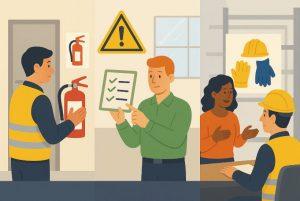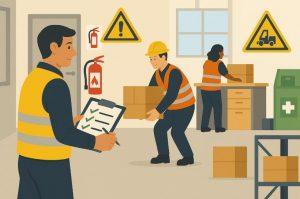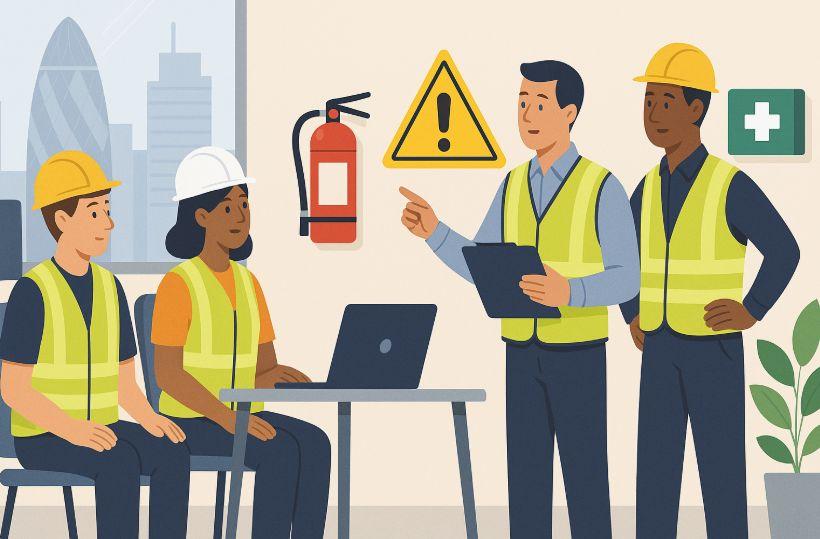Employee safety is the foundation of a productive workplace. Across London and the wider UK, health and safety training in the workplace has become a crucial aspect of business operations.
It not only fulfils legal obligations under the Health and Safety at Work Act 1974 but also protects the workforce, enhances productivity, and reduces the risk of costly incidents.
According to the Health and Safety Executive (HSE), over 561,000 non-fatal workplace injuries were recorded in the UK in 2023. Each incident represents a potential disruption to business operations, financial loss, and harm to employee wellbeing.
Implementing structured and ongoing training programmes ensures employees know how to identify hazards, operate equipment safely, and respond effectively in emergencies.
Workplace safety is more than compliance. it is a culture that every successful business must foster. But what exactly does this training involve, and why is it indispensable?
What Is Health and Safety Training in the Workplace?

Workplace safety training equips employees with the knowledge and skills required to perform their duties without unnecessary risk. Its purpose extends beyond preventing injuries; it also aims to create a confident workforce that can identify and respond to hazards proactively.
When employees understand safety protocols, they are empowered to protect themselves and their colleagues, reducing accidents and improving overall workplace morale.
Different Types of Training
Workplace training varies based on the nature of the job and the level of risk exposure. New employees typically begin with induction training, where they learn about company-specific safety policies, emergency exits, and reporting procedures.
For employees in higher-risk sectors such as construction, logistics, or chemical handling, role-specific training is necessary to teach the correct use of machinery, handling of hazardous substances, and proper use of personal protective equipment (PPE).
Safety training is not a one-time exercise. Ongoing refresher courses and toolbox talks are critical to ensure employees remain alert to emerging risks and any changes in workplace procedures.
Legal Requirements in the UK
The UK imposes strict legal responsibilities on employers through legislation such as:
- The Health and Safety at Work Act 1974 – Requires employers to protect the health, safety, and welfare of their employees.
- The Management of Health and Safety at Work Regulations 1999 – Mandates risk assessments and the provision of adequate safety training.
- RIDDOR – Requires reporting of injuries and dangerous occurrences.
Failing to provide adequate training can lead to fines, legal claims, and, in severe cases, criminal prosecution.
Why Is Health and Safety Training Important for Businesses?
Effective training is not just a legal requirement. it is a cornerstone of operational success.
Protecting Employee Safety and Wellbeing
Employees who are properly trained are less likely to suffer injuries or accidents. A workforce that feels safe is also more motivated, engaged, and productive. Safety is directly linked to employee morale, which in turn impacts retention rates and performance.
Reducing Workplace Accidents
Most workplace accidents are preventable. Incidents often stem from human error, lack of awareness, or negligence. By ensuring employees are well-trained, businesses can significantly reduce the risk of injuries. For instance, a London logistics firm saw a 40% decrease in workplace injuries after implementing monthly refresher courses and practical demonstrations.
Improving Productivity and Building Trust
A safe workplace is a productive workplace. Employees can focus on their tasks without fear of harm, and managers spend less time handling incident reports. Furthermore, businesses that demonstrate a commitment to safety are more likely to earn trust from clients, customers, and regulatory authorities.
How Can Proper Training Help Businesses Stay Legally Compliant?
Understanding Employer Responsibilities
Businesses operating in London must comply with strict safety regulations. Beyond protecting staff, proper training ensures businesses can demonstrate due diligence in the event of an inspection or legal inquiry.
Employers are required to conduct risk assessments, provide appropriate safety resources, and maintain comprehensive training records to prove compliance with HSE standards.
The Role of Training in Avoiding Penalties
When workplace incidents occur, the HSE often investigates whether employees were adequately trained. A lack of evidence can result in fines, lawsuits, or even criminal charges. In contrast, businesses with structured training programmes and updated training logs can protect themselves legally.
What Are the Key Components of Effective Workplace Safety Training?

Comprehensive Induction Programmes
The first step in a safe working environment is a solid induction programme for new hires. This programme introduces company-specific safety policies, fire and emergency procedures, and the basics of hazard reporting. Employees leave induction knowing how to act in case of an emergency.
Refresher Courses and Continuous Learning
Safety training cannot remain static. Workplaces evolve, machinery is updated, and regulations change. Ongoing refresher courses and short toolbox talks keep employees alert and informed, reducing complacency over time.
Specialised Training for High-Risk Roles
Certain roles require advanced instruction. Construction workers, chemical handlers, and machine operators need hands-on demonstrations and periodic evaluations to ensure they remain competent in high-risk environments.
How Can Employers Implement an Effective Training Programme?
An effective programme requires careful planning, delivery, and monitoring.
| Step | Description | Example |
| Assess Training Needs | Identify risks for each role and workspace | Evaluating forklift safety in warehouses |
| Develop Training Content | Prepare materials that are clear, compliant, and practical | Safety manuals, e-learning modules |
| Deliver Training | Use certified trainers or blended learning methods | Hands-on equipment sessions |
| Measure Effectiveness | Track incidents and evaluate staff performance | Safety assessments after courses |
| Continuous Improvement | Update training based on new laws or incidents | Annual safety audits and reviews |
Businesses that follow these steps not only meet their legal obligations but also build a lasting culture of safety.
How Does Health and Safety Training Reduce Workplace Accidents?
Identifying and Eliminating Hazards Early
Training equips employees to spot risks before they escalate. For example, a trained staff member will recognise frayed wires or incorrectly stored chemicals and report them immediately, preventing accidents.
Promoting a Safety-First Culture
When safety becomes part of the organisational culture, employees instinctively follow procedures and support each other in hazard prevention. Over time, this proactive attitude leads to a significant drop in incident rates.
Evidence from UK Case Studies
According to the HSE 2023 report, businesses that implemented comprehensive safety training experienced 25–40% fewer incidents, highlighting that consistent employee education directly translates to safer workplaces.
What Are the Best Practices for Maintaining Ongoing Workplace Safety?

Regular Safety Inspections and Audits
Routine inspections help identify new risks, evaluate safety equipment, and ensure ongoing compliance with HSE standards.
Encouraging Employee Reporting
Establishing a no-blame reporting culture encourages employees to raise safety concerns without fear, ensuring hazards are addressed quickly.
Integrating Safety into Daily Operations
Businesses that embed safety into their KPIs, meetings, and reward structures create a lasting commitment to employee wellbeing and operational excellence.
How to Choose the Right Health and Safety Training Provider?
Choosing a provider requires balancing accreditation, delivery methods, and value for money.
Accredited providers such as NEBOSH, IOSH, or CITB-certified trainers ensure that the content aligns with UK legislation. Businesses should also decide between online training, which is cost-effective and flexible, and on-site training, which allows for hands-on experience. Many organisations opt for blended solutions that combine the best of both approaches.
Quality training providers offer post-course assessments, certifications, and support for refresher sessions, helping businesses maintain compliance effortlessly.
How Can Technology Improve Workplace Health and Safety Training?
Technology has transformed how businesses in London and across the UK deliver health and safety training. Traditional methods like classroom sessions or paper-based manuals are increasingly being replaced by digital learning solutions that enhance engagement and retention.
E-Learning and Virtual Classrooms
E-learning platforms allow employees to access safety modules anytime, making it easier for companies to provide consistent and standardised training. Virtual classrooms and interactive webinars also facilitate real-time instruction for remote workers or multi-site teams.
Virtual and Augmented Reality (VR/AR) Training
Some industries now rely on VR and AR simulations to create safe, immersive environments for high-risk tasks. For example, a construction worker can learn to operate heavy machinery virtually, reducing the risk of accidents during real-world practice.
Digital Tracking and Compliance Tools
Modern learning management systems (LMS) track training progress, certification expirations, and compliance reports automatically. This ensures businesses can provide evidence of training during audits and inspections, helping to avoid fines.
By integrating technology, organisations can make safety training more efficient, cost-effective, and scalable, all while improving employee engagement and knowledge retention.
What Are the Financial Benefits of Investing in Health and Safety Training?

Some businesses hesitate to invest in comprehensive safety training due to upfront costs, but the long-term financial benefits far outweigh the expense.
Lower Insurance Premiums and Fewer Legal Claims
Insurance providers often offer reduced premiums to businesses with excellent safety records. Fewer accidents also mean fewer compensation claims, which can otherwise result in significant payouts.
Reduced Downtime and Operational Disruptions
Accidents often lead to equipment damage, investigations, and operational stoppages. A trained workforce that prevents incidents helps maintain consistent productivity and reduces unplanned downtime.
Enhanced Reputation and Client Confidence
Companies with robust safety training programmes are more likely to attract contracts, especially in sectors where safety performance is a key requirement. A positive reputation can lead to increased revenue opportunities.
In essence, safety training is not just a compliance expense. it is an investment in operational efficiency, risk reduction, and business growth.
Conclusion
Investing in health and safety training in the workplace is not an optional exercise. it is a strategic decision that safeguards employees, ensures legal compliance, and enhances business performance.
By implementing structured training programmes, fostering a safety-focused culture, and staying compliant with UK legislation, businesses in London and beyond can minimise risks, boost productivity, and secure long-term operational success.
FAQs
How often should workplace safety training take place?
Most workplaces require induction training for new hires and annual refresher courses, or more frequently if the workplace environment changes.
What happens if a business ignores safety training?
Failure to train employees can lead to HSE fines, compensation claims, and in serious cases, criminal liability.
Is online safety training enough for high-risk roles?
Online training works well for theory, but hands-on practice is essential for roles involving machinery or hazardous materials.
How can businesses measure training effectiveness?
Tracking incident rates, conducting safety audits, and employee assessments are effective evaluation methods.
Which employees require advanced safety training?
Those in construction, warehousing, chemical handling, and machinery operation need specialised instruction.
Are there affordable options for small businesses?
Yes. Free HSE materials, e-learning platforms, and government-subsidised courses can reduce training costs.
What is the role of employees in maintaining workplace safety?
Employees must follow training, report hazards promptly, and participate in refresher programmes.









Leave feedback about this